Mapping and Analyses of Land Subsidence in Hengshui, China, Based on InSAR Observations
Abstract
:1. Introduction
2. Geological Settings and Data Acquisition
2.1. Quaternary Stratum and Aquifers
2.2. Groundwater Tables
2.3. SAR Data Acquisitions
3. InSAR Method and Data Processing
4. Results
5. Discussions
5.1. Relationship between Land Subsidence and Aquifer Properties
5.2. Relationship between Land Subsidence and Central Table of Groundwater Depression
5.3. Relationship between Land Subsidence and Groundwater Tables, Hydraulic Head Declines of Confined Aquifers
5.4. Relationship between Total Hydraulic Head Variation and Time-Series Subsidence
6. Conclusions
Author Contributions
Funding
Data Availability Statement
Acknowledgments
Conflicts of Interest
References
- Wang, M.-Y. Research on Land Subsidence Mechanism and Prediction of Settlement in Hengshui Area. Master’s Thesis, China University of Geosciences, Beijing, China, 2016; pp. 7–26. [Google Scholar]
- Wang, S. Characteristics of Groundwater Chemistry and Hydrogeochemical Process on Shijiazhuang-Hengshui Profile. Ph.D. Dissertation, China University of Geosciences, Beijing, China, 2017; pp. 10–35. [Google Scholar]
- Zhu, J.-Y.; Guo, H.-P.; Li, W.-P.; Tian, X.-W. Relationship between land subsidence and deep groundwater yield in the North China Plain. South North Water Transf. Water Sci. Technol. 2014, 12, 165–169. [Google Scholar]
- Guo, H.-P.; Bai, J.-B.; Zhang, Y.-Q.; Wang, L.-Y.; Shi, J.-S.; Li, W.-P.; Zhang, Z.-C.; Wang, Y.-L.; Zhu, J.-Y.; Wang, H.-G. The evolution characteristics and mechanism of the land subsidence in typical areas of the North China Plain. Geol. China 2017, 44, 1115–1127. [Google Scholar]
- He, Q.-C.; Liu, W.-B.; Li, Z.-M. Land subsidence survey and monitoring in the North China Plain. Geol. J. China Univ. 2006, 12, 195–209. [Google Scholar]
- He, X. Study on Dynamic Response of Groundwater under Heavy Rainfall. Master’s Thesis, China University of Geosciences, Beijing, China, 2016; pp. 5–12. [Google Scholar]
- Peng, M.-M.; Lu, Z.; Zhao, C.-Y.; Motagh, M.; Bai, L.; Conway, B.-D.; Chen, H.-Y. Mapping land subsidence and aquifer system properties of the Willcox Basin, Arizona, from InSAR observations and independent component analysis. Remote Sens. Environ. 2022, 271, 112894. [Google Scholar] [CrossRef]
- Li, Z.-M. Characteristics and Mechanism of Land Subsidence in Hebei Plain. Ph.D. Dissertation, China University of Geosciences, Beijing, China, 2012; pp. 8–44. [Google Scholar]
- Zhang, X.-Z. Dynamic characteristics of deep groundwater in Hengshui City. Shaanxi Water Resour. 2018, 2, 23–25. [Google Scholar]
- Hebei Water Resources Bulletin. 2012–2021. Available online: http://slt.hebei.gov.cn/a/zfxxgk/zc/ (accessed on 1 August 2023).
- Ali, M.-Z.; Chu, H.-J.; Burbey, T.-J. Mapping and predicting subsidence from spatio-temporal regression models of groundwater-drawdown and subsidence observations. Hydrogeol. J. 2020, 28, 2865–2876. [Google Scholar] [CrossRef]
- Jia, C.; Di, S.-T.; Sun, X.-X.; Zhang, S.-P.; Ding, P.-P.; Liu, Z.-T. Spatiotemporal evolution characteristics and Transfer law of land subsidence in sand-clay interbed caused by exploiting the groundwater. Arab. J. Sci. Eng. 2021, 46, 5733–5753. [Google Scholar] [CrossRef]
- Ma, D.-M.; Zhao, R.; Li, Y.-S.; Li, Z.-G. Land subsidence assessment of an Archipelago based on the InSAR time series analysis method. Water 2023, 15, 465. [Google Scholar] [CrossRef]
- Yousefi, R.; Talebbeydokhti, N. Subsidence monitoring by integration of time series analysis from different SAR images and impact assessment of stress and aquitard thickness on subsidence in Tehran, Iran. Environ. Earth Sci. 2021, 80, 418. [Google Scholar] [CrossRef]
- Ng, A.-H.; Ge, L.-L.; Li, X.-J. Assessments of land subsidence in the Gippsland Basin of Australis using ALSO PALSAR data. Remote Sens. Environ. 2015, 159, 86–101. [Google Scholar] [CrossRef]
- Candela, T.; Koster, K. The many faces of anthropogenic subsidence. Science 2022, 376, 1381–1382. [Google Scholar] [CrossRef] [PubMed]
- Li, M.; Ge, D.-Q.; Liu, B.; Zhang, L.; Wang, Y.; Guo, X.-F.; Wang, Y.; Zhang, D.-D. Research on development characteristics and failure mechanism of land subsidence and ground fissure in Xi’an, monitoring by using time-series SAR interferometry. Geomat. Nat. Hazards Risk 2019, 10, 699–718. [Google Scholar] [CrossRef]
- Li, M.; Ge, D.-Q.; Zhang, L.; Guo, X.-F.; Liu, B.; Wang, Y.; Wu, Q. Assessment of the temporal-spatial evolution of subsidence and its driving mechanism in the Beijing Plain (China) by using SAR interferometry and geological data. Geomat. Nat. Hazards Risk 2021, 12, 2708–2735. [Google Scholar] [CrossRef]
- Chaussard, E.; Amelung, F.; Abidin, H.; Hong, S.-H. Sinking cities in Indonesia: ALSO PALSAR detects rapid subsidence due to groundwater and gas extraction. Remote Sens. Environ. 2013, 128, 150–161. [Google Scholar] [CrossRef]
- Zhao, Z.-H. Analysis of the neotectonic activity and the bad geological phenomenon caused by it in Beijing Plain areas. J. Geol. Hazards Environ. Preserv. 2009, 20, 66–70. [Google Scholar]
- Bekaert, D.; Walters, R.; Wright, T.; Hooper, A.; Parker, D. Statistical comparison of InSAR tropospheric correction techniques. Remote Sens. Environ. 2015, 170, 40–47. [Google Scholar] [CrossRef]
- Sneed, M.; Brandt, J. Detection and Messurement of Land Subsidence Using Global Positioning System Surveying and Interferometric Synthetic Aperture Radar; Scientific Investigations Report 2007–5251; US Department of the Interior, US Geological Survey: Washington, DC, USA, 2013; pp. 1–30. [Google Scholar] [CrossRef]
- Ferretti, A. Satellite InSAR Data Reservoir Monitoring from Space; EAGE Publications BV: Scheveningen, The Netherlands, 2014; pp. 8–101. [Google Scholar]
- Berardino, P.; Fornaro, G.; Lanari, R.; Sansosti, E. A new algorithm for surface deformation monitoring based on small baseline differential SAR interferograms. IEEE Trans. Geosci. Remote Sens. 2002, 40, 2375–2383. [Google Scholar] [CrossRef]
- Ge, D.-Q.; Wang, Y.; Guo, X.-F.; Liu, S.-W.; Fan, J.-H. Surface deformation monitoring with multi-baseline D-InSAR based on coherent point target. J. Remote Sens. 2007, 11, 574–580. [Google Scholar]
- Tizzani, P.; Berardino, P.; Casu, F.; Euillades, P.; Manzo, M.; Ricciardi, G.-P.; Zeni, G.; Lanari, R. Surface deformation of Long Valley caldera and Mono Basin, California, investigated with the SBAS-InSAR approach. Remote Sens. Environ. 2007, 108, 277–289. [Google Scholar] [CrossRef]
- Hooper, A.; Bekaert, D.; Spaans, K.; Arikan, M. Recent advances in SAR interferometry time series analysis for measuring crustal deformation. Tectonophysics 2012, 514–517, 1–13. [Google Scholar] [CrossRef]
- Ge, D.-Q.; Zhang, L.; Wang, Y.; Guo, X.-F.; Wang, Y. A Monitoring Method with Integrating Multi-Orbit and Long-Strip CTInSAR about Regional Land Subsidence. National Invention Patent of the People’s Republic of China No: ZL 2014 1 0353927.3, 2017. Available online: https://www.zhangqiaokeyan.com/patent-detail/061202322554.html (accessed on 3 August 2022).
- Ferretti, A.; Prati, A.; Rocca, F. Permanent scatterers in SAR Interferometry. IEEE Trans. Geosci. Remote Sens. 2001, 39, 8–20. [Google Scholar] [CrossRef]
- Li, G.-R.; Zhao, C.-Y.; Wang, B.-H.; Peng, M.-M.; Bai, L. Evolution of spatiotemporal ground deformation over 30 years in Xi’an, China, with multi-sensor SAR interferometry. J. Hydrol. 2023, 616, 128764. [Google Scholar] [CrossRef]
- Dong, J.; Guo, S.-K.; Wang, N.; Zhang, L.; Ge, D.-Q.; Liao, M.-S.; Gong, J.-Y. Tri-decadal evolution of land subsidence in the Beijing Plain revealed by multi-epoch satellite InSAR observations. Remote Sens. Environ. 2023, 286, 113446. [Google Scholar] [CrossRef]
- Raucoules, D.; Cartannaz, C.; Mathieu, F.; Midot, D. Combined use of space-borne SAR interferometric techniques and ground-based measurements on a 0.3 km2 subsidence phenomenon. Remote Sens. Environ. 2013, 139, 331–339. [Google Scholar] [CrossRef]
- Chatterjee, R.-S.; Fruneau, B.; Rudant, J.-P.; Roy, P.-S.; Frison, P.-L.; Lakhera, R.-C.; Dadhwal, V.-K.; Saha, R. Subsidence of Kolkata (Calcutta) City, India during the 1990s as observed from space by Differential Synthetic Aperture Radar Interferometry (D-InSAR) techique. Remote Sens. Environ. 2006, 102, 176–185. [Google Scholar] [CrossRef]
- RADARSAT-2 Satellite Characteristics. 2015. Available online: http://www.asc-csa.gc.ca/eng/satellites/radarsat/radarsat-tableau.asp (accessed on 1 August 2023).
- Jiang, L.-M.; Lin, H.; Ma, J.-W.; Kong, B.; Wang, Y. Potential of small-baseline SAR interferometry for monitoring land subsidence related to underground coal fires:Wuda (Northern China) case study. Remote Sens. Environ. 2011, 115, 257–268. [Google Scholar] [CrossRef]
- Hooper, A.; Zebker, H.; Segall, P.; Kampes, B. A new method for measuring deformation on volcanoes and other natural terrains using InSAR persistent scatterers. Geophys. Res. Lett. 2004, 31, L23611. [Google Scholar] [CrossRef]
- Wright, T.-J.; Parsons, B.-E.; Lu, Z. Toward mapping surface deformation in three dimensions using InSAR. Geophys. Res. Lett. 2004, 31, L01607. [Google Scholar] [CrossRef]
- Teatini, P.; Strozzi, T.; Tosi, L.; Wegmüller, U.; Werner, C.; Carbognin, L. Assessing short- and long-time displacements in the Venice coastland by synthetic aperture radar interferometric point target analysis. J. Geophys. Res. 2007, 112, F01012. [Google Scholar] [CrossRef]
- Stramondo, S.; Bozzano, F.; Marra, F.; Wegmuller, U.; Cinti, F.-R.; Moro, M.; Saroli, M. Subsidence induced by urbanisation in the city of Rome detected by advanced InSAR technique and geotechnical investigations. Remote Sens. Environ. 2008, 112, 3160–3172. [Google Scholar] [CrossRef]
- Water Resources Bulletin of Hebei Province. 2012–2022. Available online: https://slt.hebei.gov.cn/ (accessed on 1 August 2023).
- Zeitoun, D.-G.; Wakshal, E. Fundamentals of the Consolidation Theory for Soils. In Land Subsidence Analysis in Urban Areas; Springer: Berlin/Heidelberg, Germany, 2013; pp. 75–117. [Google Scholar] [CrossRef]
- Selvadurai, A.-P.-S. Irreversibility of soil skeletal deformations: The Pedagogical Limitations of Terzaghi’s celebrated model for soil consolidation. Comput. Geotech. 2021, 135, 104137. [Google Scholar] [CrossRef]
- Shen, X.-Y.; Ch, Z.-H. Primary Consolidation Theory of Saturated Soft Clay (Continuation): The Relationship between Clay’s Water Content and Time during Primary Consolidation. Earth Sci. 2009, 34, 861–869. [Google Scholar]
- Unconsolidated Soil. Available online: https://baike.baidu.com/item/%E6%AC%A0%E5%9B%BA%E7%BB%93%E5%9C%9F/4753061?fromModule=search-result_lemma-recommend (accessed on 1 August 2023).
- Terzaghi, K. Principles of soil mechanics: IV. Settlement and consolidation of clay. Eng. News Rec. 1925, 95, 874–878. [Google Scholar]
- Chaussard, E.; Bürgmann, R.; Shirzaei, M.; Fielding, E.-J.; Baker, B. Predictability of hydraulic head changes and characterization of aquifer-system and fault properties from InSAR-derived ground deformation. J. Geophys. Res. Solid Earth 2014, 119, 6572–6590. [Google Scholar] [CrossRef]
- Hoffmann, J.; Galloway, D.-L.; Zebker, H.-A. Inverse modeling of interbed storage parameters using land subsidence observations, Antelope Valley, California. Water Resour. Res. 2003, 39, 1031. [Google Scholar] [CrossRef]
- Jiang, L.; Bai, L.; Zhao, Y.; Cao, G.; Wang, H.; Sun, Q. Combining InSAR and hydraulic head measurements to estimate aquifer parameters and storage variations of confined aquifer system in Cangzhou, North China Plain. Water Resour. Res. 2018, 54, 8234–8252. [Google Scholar] [CrossRef]
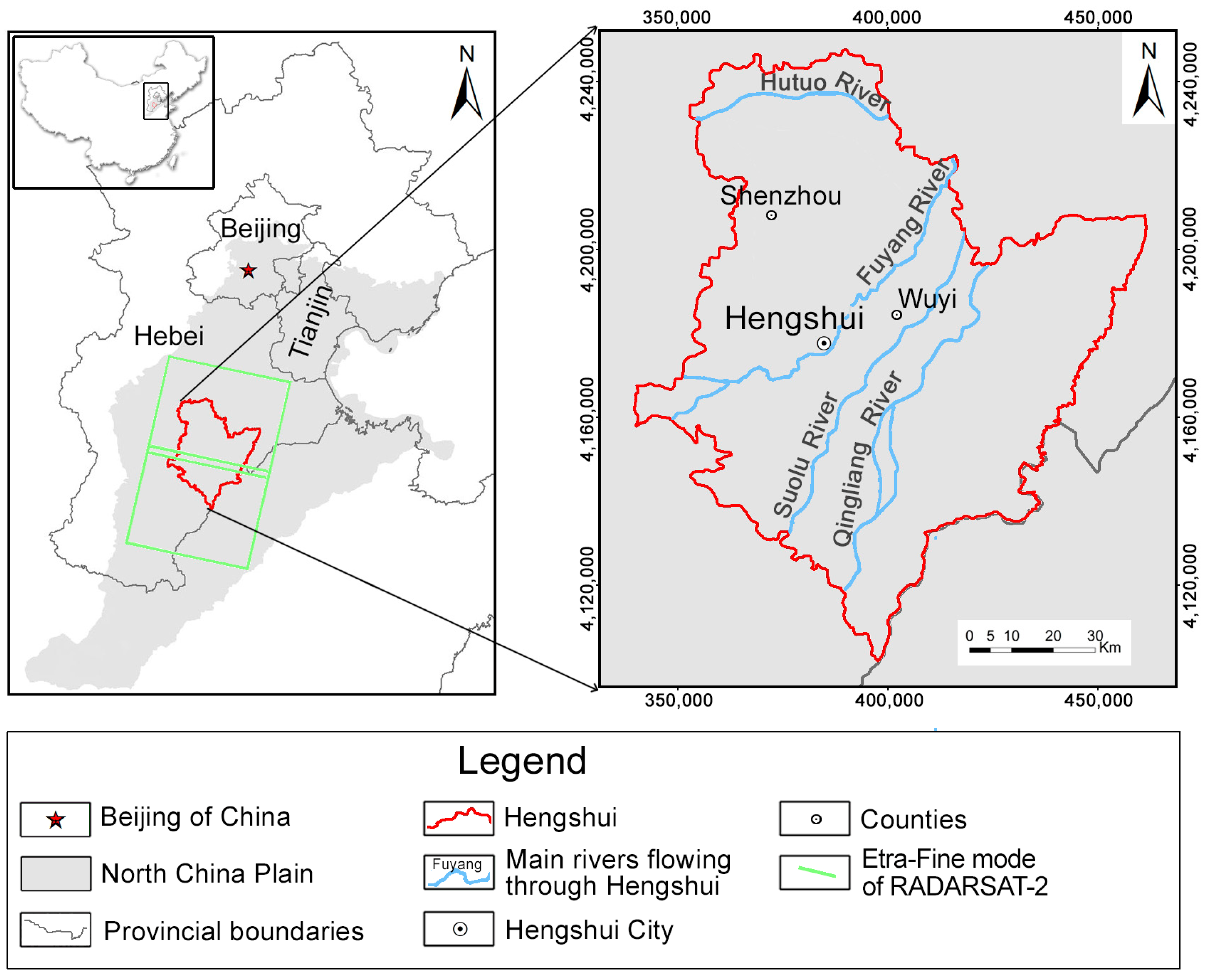
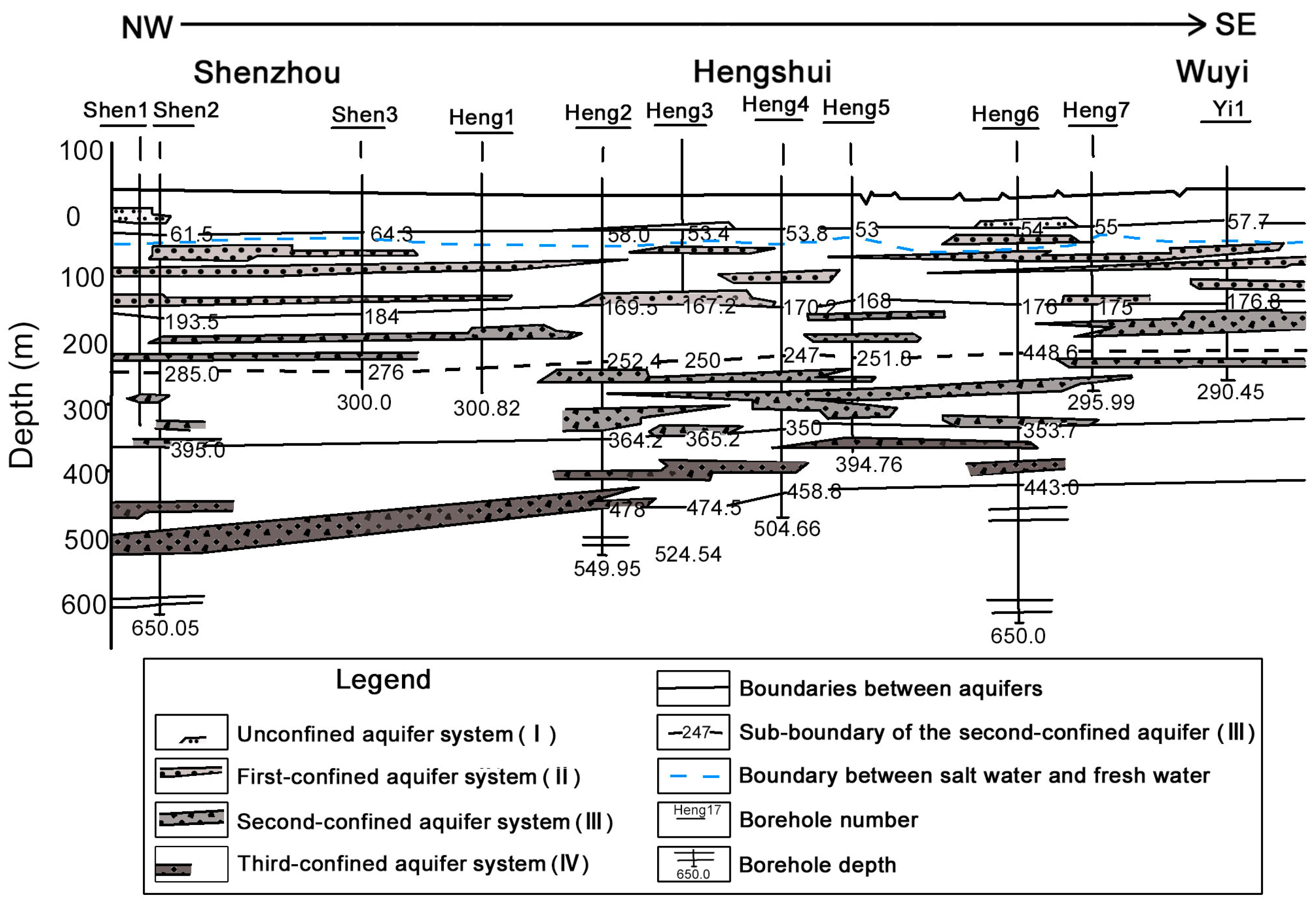
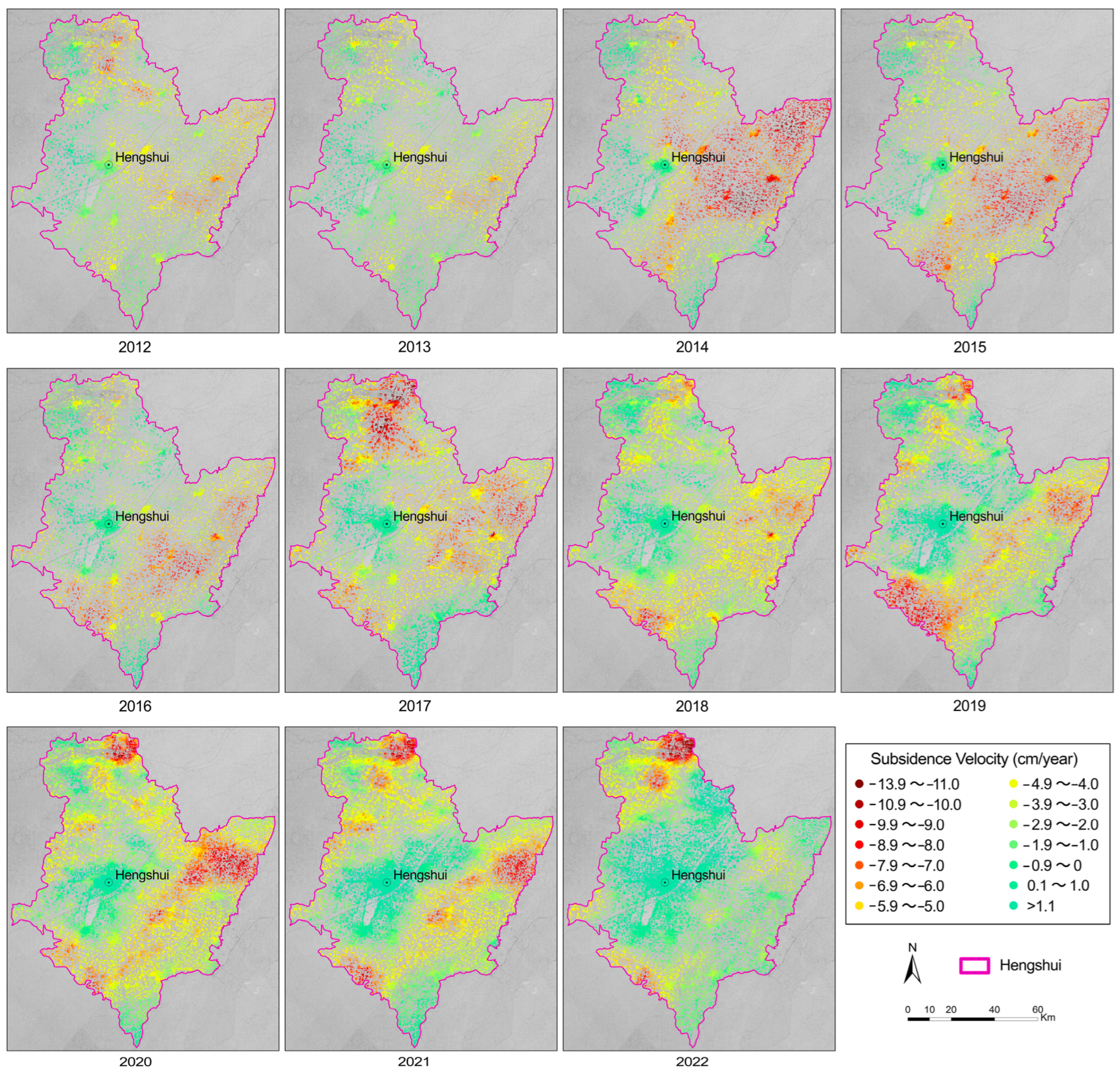
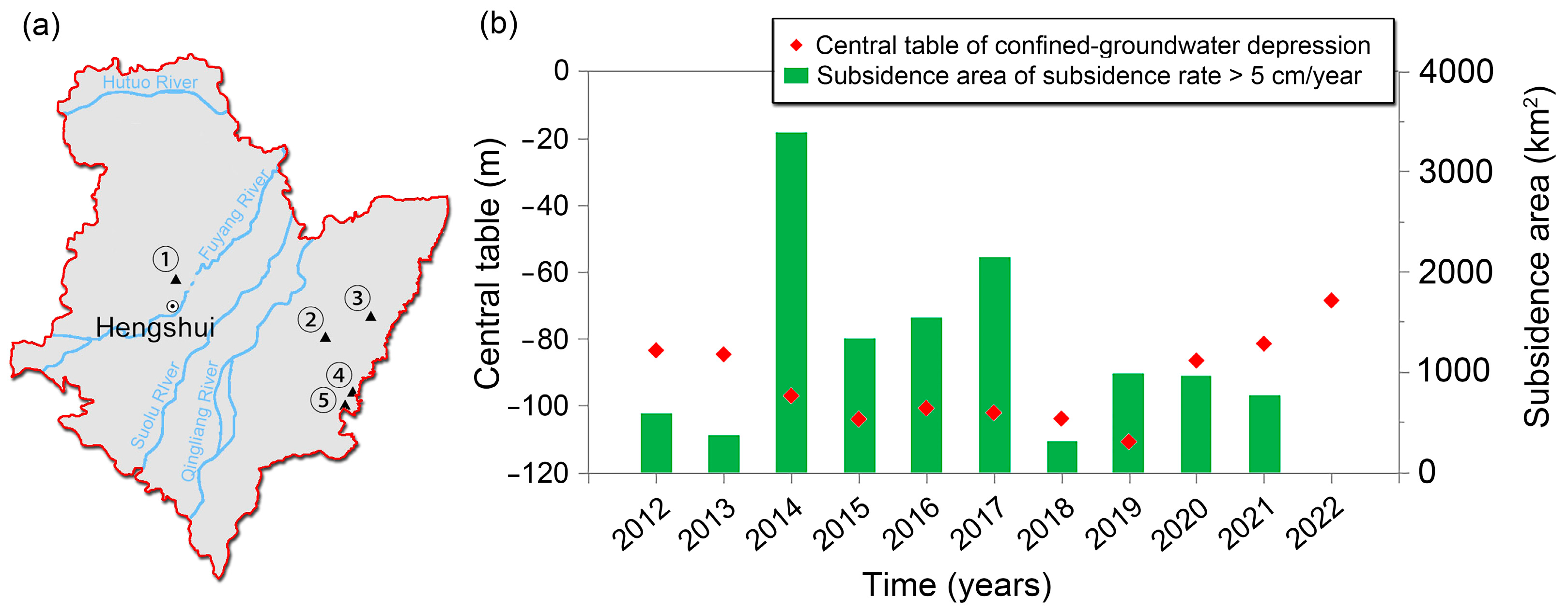
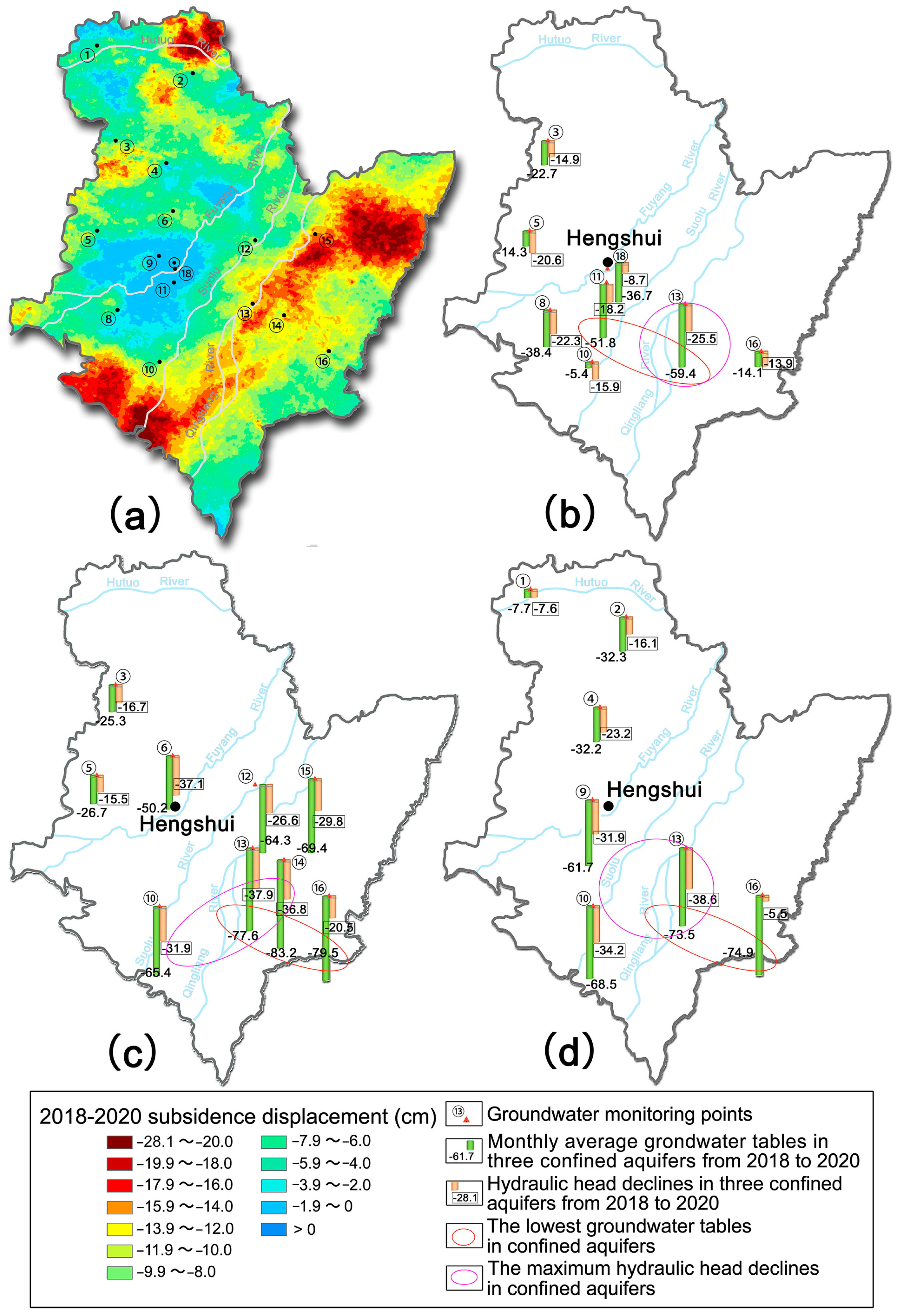

| No. | Image Mode | Obite Type | Swath of Scene (km) | Scene Number | Number of Each Scene | Total Number of Scenes | Time Span |
|---|---|---|---|---|---|---|---|
| 1. | Wide | Descending | 150 × 150 | 2 | 14 | 28 | Sep.2011–Oct.2012 Sep.2012–Oct.2013 Sep.2013–Oct.2014 Sep.2014–Oct.2015 Sep.2015–Oct.2016 |
| 2. | Etra- Fine | Descending | 125 × 125 | 2 | 14 | 28 | Sep.2016–Oct.2017 Sep.2017–Oct.2018 Sep.2018–Oct.2019 Sep.2019–Oct.2020 Sep.2020–Oct.2021 Sep.2021–Oct.2022 |
| Hutuo River Basin | Fuyang, Suolu and Qingliang Basin | |||
|---|---|---|---|---|
| Annual maximum vertical rates of subsidence (cm/year) | The coverage areas with average rates of subsidence of >5.0 cm/year (km2) | Annual maximum vertical rates of subsidence (cm/year) | The coverage areas with average rates of subsidence of >8.0 cm/year (km2) | |
| 2012 | 10.2 | 52 | 8.1 | 0 |
| 2013 | 6.6 | 55 | 7.7 | 0 |
| 2014 | 7.5 | 89 | 13.0 | 971 |
| 2015 | 6.4 | 51 | 10.6 | 1 |
| 2016 | 7.0 | 76 | 10.3 | 44 |
| 2017 | 13.8 | 1012 | 13.9 | 119 |
| 2018 | 8.2 | 119 | 11.6 | 7 |
| 2019 | 9.5 | 141 | 10.4 | 178 |
| 2020 | 11.8 | 193 | 10.8 | 191 |
| 2021 | 11.3 | 201 | 10.8 | 124 |
| 2022 | 12.3 | 241 | 9.5 | 0 |
| The Lowest Groundwater Tables | The Maximum Hydraulic Head Declines | |||
|---|---|---|---|---|
| Location | Value (m) | Location | Value (m) | |
| The first-confined aquifer (II) | ⑪ | −51.8 | ⑪ | −18.2 |
| ⑬ | −59.4 | ⑬ | −25.5 | |
| The upper portion of second-confined aquifer (III1) | ⑬ | −77.6 | ⑩ | −31.9 |
| ⑭ | −83.2 | ⑬ | −37.9 | |
| ⑯ | −79.5 | ⑭ | −36.8 | |
| The lower portion of second-confined aquifer (III2) | ⑬ | −73.5 | ⑨ | −31.9 |
| ⑯ | −74.9 | ⑩ | −34.2 | |
| ⑬ | −38.6 | |||
Disclaimer/Publisher’s Note: The statements, opinions and data contained in all publications are solely those of the individual author(s) and contributor(s) and not of MDPI and/or the editor(s). MDPI and/or the editor(s) disclaim responsibility for any injury to people or property resulting from any ideas, methods, instructions or products referred to in the content. |
© 2023 by the authors. Licensee MDPI, Basel, Switzerland. This article is an open access article distributed under the terms and conditions of the Creative Commons Attribution (CC BY) license (https://creativecommons.org/licenses/by/4.0/).
Share and Cite
Li, M.; Ge, D.; Guo, X.; Zhang, L.; Liu, B.; Wang, Y.; Wu, Q.; Wan, X.; Wang, Y. Mapping and Analyses of Land Subsidence in Hengshui, China, Based on InSAR Observations. Land 2023, 12, 1684. https://doi.org/10.3390/land12091684
Li M, Ge D, Guo X, Zhang L, Liu B, Wang Y, Wu Q, Wan X, Wang Y. Mapping and Analyses of Land Subsidence in Hengshui, China, Based on InSAR Observations. Land. 2023; 12(9):1684. https://doi.org/10.3390/land12091684
Chicago/Turabian StyleLi, Man, Daqing Ge, Xiaofang Guo, Ling Zhang, Bin Liu, Yan Wang, Qiong Wu, Xiangxing Wan, and Yu Wang. 2023. "Mapping and Analyses of Land Subsidence in Hengshui, China, Based on InSAR Observations" Land 12, no. 9: 1684. https://doi.org/10.3390/land12091684
APA StyleLi, M., Ge, D., Guo, X., Zhang, L., Liu, B., Wang, Y., Wu, Q., Wan, X., & Wang, Y. (2023). Mapping and Analyses of Land Subsidence in Hengshui, China, Based on InSAR Observations. Land, 12(9), 1684. https://doi.org/10.3390/land12091684





